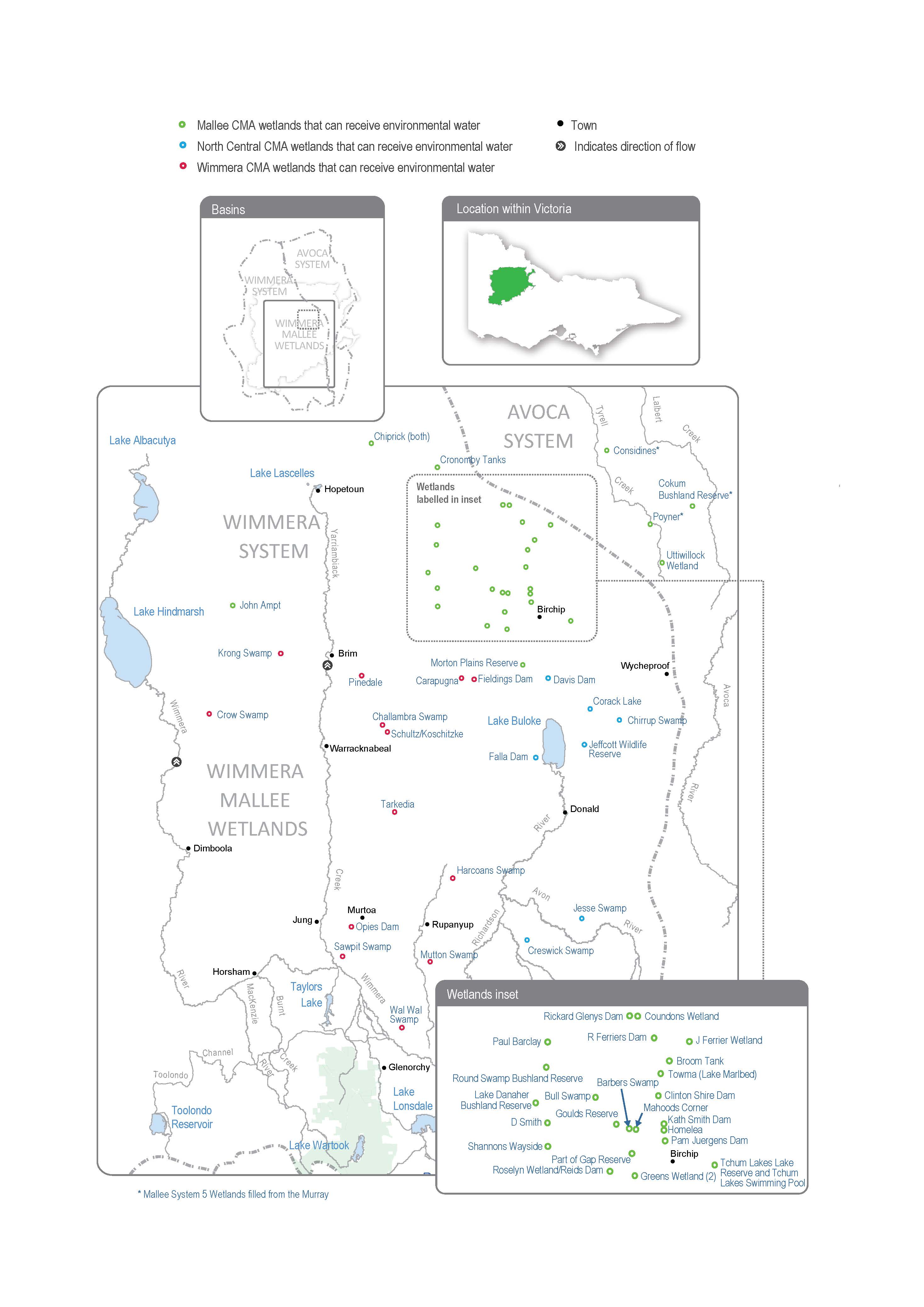On this page:
Latest information about where, when and why environmental water may be delivered to the Wimmera-Mallee wetlands and the environmental objectives being targeted is available in this year’s seasonal watering plan.
The seasonal watering plan also contains information about how environmental flows could support cultural, social, recreational and economic values in the Wimmera-Mallee wetlands.
Watering data for the Wimmera system and the wider western region is updated quarterly. Visit current watering releases to find out more.
To find out the current environmental water entitlements held by the VEWH in the Wimmera-Mallee wetlands visit our water holdings.
Environmental water in the Glenelg, Wimmera and Wimmera-Mallee wetlands systems is sourced from both the Wimmera and Glenelg basins. Information about the ownership of water entitlements in the Wimmera-Mallee wetlands system can be found under the Entitlements and Compliance section of the Wimmera basin page and Glenelg basin page at Victorian Water Accounts.
Waterway managers
Mallee Catchment Management Authority
North Central Catchment Management Authority
Wimmera Catchment Management Authority
Storage manager
Grampians Wimmera Mallee Water
Environmental Water Holder
Victorian Environmental Water Holder
Traditional Owners
Barengi Gadjin Land Council (BGLC) has a Recognition and Settlement Agreement with the Victorian Government and is a statutory authority for the management of Aboriginal heritage values and culture, under the Victorian Aboriginal Heritage Act 2006. Traditional Owners represented by BGLC hold native title (the Wotjobaluk, Jaadwa, Jadawadjali, Wergaia and Jupagulk peoples).
Dja Dja Wurrung Clans Aboriginal Corporation has a Recognition and Settlement Agreement with the Victorian Government and is the statutory authority for the management of Aboriginal heritage values and culture, under the Victorian Aboriginal Heritage Act 2006.
The Barapa Barapa people also have connections to the Wimmera-Mallee wetlands region.
System overview
The Wimmera-Mallee wetlands include 52 sites on public and private land spread across north-west Victoria. From the early 20th century until the construction of the Wimmera-Mallee Pipeline Project (WMPP) in 2010, the deeper areas of these wetlands received water most years from the open channels associated with the Wimmera Mallee Domestic and Stock Channel System.
The WMPP replaced stock and domestic supply dams with tanks and the open-channel distribution system with pipelines to improve water efficiency. A portion of the water savings from the WMPP was converted to an environmental entitlement to improve the condition of the area’s flow-stressed rivers, creeks and wetlands; the rest was used to create regional development opportunities and boost supply reliability for other users. The WMPP reduced the amount of open-water habitat in predominantly agricultural areas formerly supplied by the open-channel system, so a separate 1,000 ML environmental entitlement was created to water some of the wetlands that were previously supplied through the channel system. Fifty-two priority wetlands can receive water from this environmental entitlement.
Water for the environment can only be delivered to the wetlands when there is sufficient capacity in the Wimmera-Mallee Pipeline system, which can be affected by demand from other pipeline customers. The North Central, Mallee and Wimmera CMAs work closely with Grampians Wimmera Mallee Water and land managers (including Parks Victoria, the Department of Energy, Environment and Climate Action and private landowners) to take account of pipeline capacity constraints when ordering environmental deliveries to wetlands.
Environmental values
There are many wetland types in the Wimmera-Mallee wetlands system, including freshwater meadows, open freshwater lakes and freshwater marshes. This diversity provides various wetland habitats for plants and animals across the Wimmera-Mallee region. The wetlands also vary in size and support different vegetation communities. Some support native waterbird populations, including brolgas, egrets, blue-billed ducks, freckled ducks, Australian painted snipes and glossy ibis. The vulnerable growling grass frog, turtles and many other native animals may use the wetlands as drought refuges and drinking holes. Rare and vulnerable vegetation species (such as spiny lignum, ridged water-milfoil, chariot wheels, cane grass and the recently reintroduced marbled marshwort) are also present in some wetlands.
Falla Dam is being trialled as a reserve site for critically endangered Murray hardyhead as part of the Murray Hardyhead Native Fish Recovery Plan. Some Murray hardyhead were introduced to Falla Dam in November 2023 with the intention of them surviving and being used to restock populations at sites outside the Wimmera-Mallee wetlands system that are adversely impacted by drought or other disturbances in the future.
Page last updated: 17/03/25
